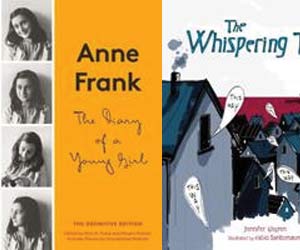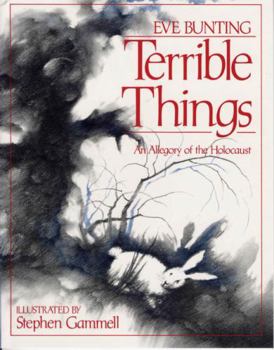Terrible Things: An Allegory of the Holocaust
Select Format
Select Condition 
Book Overview
The animals in the clearing were content until the Terrible Things came, capturing all creatures with feathers. Little Rabbit wondered what was wrong with feathers, but his fellow animals silenced... This description may be from another edition of this product.
Format:Hardcover
Language:English
ISBN:0827603258
ISBN13:9780827603257
Release Date:December 1996
Publisher:Jewish Publication Society
Length:32 Pages
Weight:0.52 lbs.
Dimensions:0.3" x 7.3" x 9.3"
Age Range:6 to 9 years
Grade Range:Grades 1 to 4
Customer Reviews
4 ratings
Territble Times
Published by Thriftbooks.com User , 18 years ago
Terrible Things by Eve Bunting is one of the best children's books I've read which addressed the Holocaust during WWII. A wonderful allegory using animals to explain to children the effect of terrible things like a Holocaust which happen to innocent people. Systematically different groups of animals are terrorized and removed from a clearing area in a forest. But the ones who are left say the ones who were removed were annoying. Then later they begin to say and think they are better then the rest till they are also removed. There is a wonderful poem written by Pastor Neirmueller about the Holocaust which ends, "When they came for me, there was nobody left to speak up for me." This reminded me so much of the book Terrible Things and I highly recommend this as a teaching tool for children when discussing the various Holocausts which have occurred all over the world.
Terrible Things By: Eve Bunting
Published by Thriftbooks.com User , 19 years ago
In this book, Eve Bunting writes about the terrible things that happened during the Holocaust. While the cruelties and injustices of the prejudice against Jews are horrid and poignant, Eve Bunting wrote this book for younger audiences. Children will not fully understand the events that happened, just the intolerance of differences. This story is an eye-opener for persons of any age. Adults and children alike will better understand the concepts of the Holocaust by reading this children's book rather than complicated histories. The woodland creatures that thrive happily in the forest are of all different species, like the people in our world today. The book does not directly state the immorality of the Holocaust, but the story introduces the thought using the terrible things that come into the forest and take away animals according to their appearances. Any audience would enjoy Terrible Things because of its honesty and pure wit. I rate the book 5 out of 5 stars because Eve Bunting makes it a sheer page-turner. Although we cannot protect younger children from the unfairness of the world, the book shows a glimpse of reality in an appropriate content. Written By: Taylor
Martin Niemoeller's lesson turned into a parable for kids
Published by Thriftbooks.com User , 20 years ago
I was curious to see how Eve Bunting would turn the Holocaust into an allegory appropriate for young children, but as soon as I started reading "Terrible Things" the inspiration for her story became clear. The Terrible Things first come to the forest for every creature with feathers on its back. The frogs, squirrels, and other animals quickly declare that they do not have feathers, that the forest is better without the birds, and that they are all glad that it was not them that the Terrible Things wanted. Clearly Eve Bunting takes her text from the famous statement attributed to Martin Niemoeller. If I remember correctly Niemoeller was a pastor. He told about how in Germany the Nazis first came for the Communists, but since he was not a Communist he did not speak up. Then they came for the Jews, but again he did not speak up because he was not a Jew. The same rationale explained his silence when they came for the trade unionists and Catholics. "Then they came for me," Niemoeller said, "and by that time no one was left to speak up." Niemoeller's words might be the most famous declaration about the Holocaust and its appropriateness for being the basis of an allegory for young children should be self-evident. Bunting is not talking as much about the mass exterminations by the Nazis as she is about the culpability of the ordinary citizens who looked the other way when terrible things happened in Germany. The rhetorical question Bunting asks is "If everybody had stood together at the first sign of evil would this have happened?" If young children do not know the answer to that question before they read "Terrible Things," they certainly will afterwards.Before she tells the story, which is illustrated by Stephen Gammell with pencil drawings, Bunting provides the moral for her tale. Acknowledging that standing up for what you know is right is not always easy, especially when you are facing someone biggers and stronger than you are, Bunting admits to her readers that it is easier to look the other way, "But if you do, terrible things can happen." The strength of "Terrible Things" is that Bunting makes the lesson Niemoeller shared about the Holocaust easily recognizable and understandable to young children.
Compelling, allows understanding of how Holcaust happened.
Published by Thriftbooks.com User , 25 years ago
The Holocaust is an event so vast in the scope of its horror that it can be hard for anyone, let alone a child, to understand how it happened. Eve Bunting's The Terrible Things uses an allegory of forest animals to help children (and, frankly, adults) grasp how it is that ordinary people like themselves and people they know could have allowed the Holocuast to happen. While it does not deal directly with the Holocuast itself, The Terrible Things does deal with the fear and shifting of responsibility that allowed it and similar events to happen. In the book "The Terrible Things" (which are never pictured concretely in illustrations) come for one after another group of forest animals while those not included in the roundup do nothing, until - of course - there are none left. This book is clear and understandable but not frightening or disturbing. Indeed, it is a picture book much like any other children's picture book. Hence, I wouldn't worry about introducing it to elementary age students. In fact, this book would probably be my top choice for an initial introduction to the Holocaust.This book also carries a poignant message about integrity and responsibility to persons of any age. Eve Bunting artfully captures the essence of what John Donne meant in writing "no man is an island." She also helps us to comprehend what is most incomprhensible: one of the reasons decent people allowed the evil of the Holocaust to go on.
Terrible Things: An Allegory of the Holocaust Mentions in Our Blog

Reads for All Ages on International Holocaust Remembrance Day
Published by Ashly Moore Sheldon • January 27, 2021
International Holocaust Remembrance Day marks the liberation of Auschwitz on January 27 in 1945. For so many reasons, it is important to learn about this dark chapter in history. The books highlighted here offer a variety of perspectives and stories for all ages.




